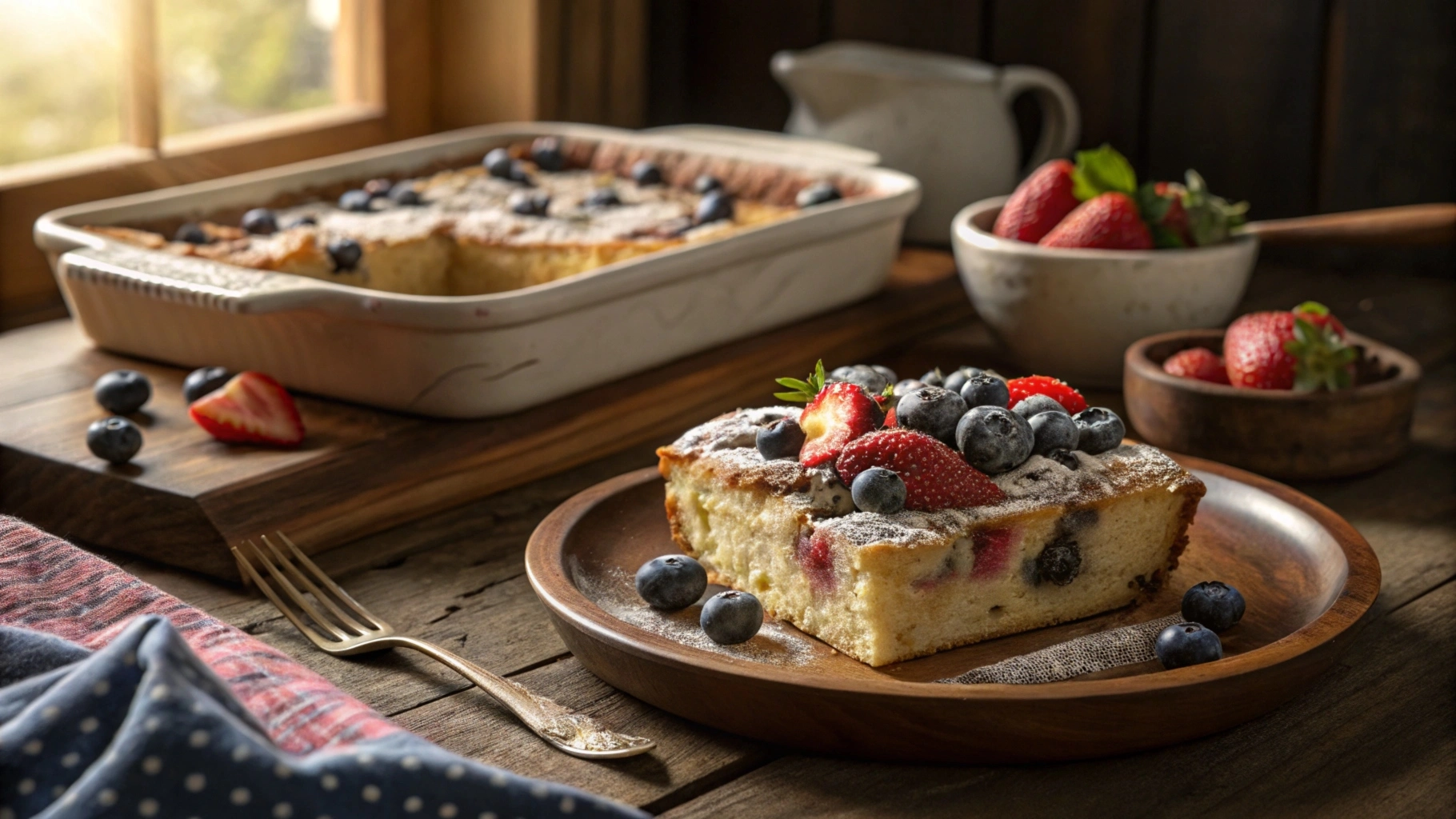Finding the ideal breakfast option can be tricky when you’re on a gluten-free diet. Sweet, gluten-free breakfast casseroles are the ultimate solution — a perfect blend of flavor, simplicity, and nourishment. Whether you’re meal prepping for the week or hosting a weekend brunch, these casseroles make mornings exciting without compromising your dietary needs.
Looking to diversify your gluten-free breakfast menu? Explore these gluten-free breakfast casserole recipes for inspiration that will elevate your mornings.
Why Sweet Breakfast Casseroles Are a Must-Try
Sweet breakfast casseroles are not just indulgent; they’re also incredibly versatile. They are perfect for anyone who loves comforting dishes that can double as a hearty breakfast or a quick snack. Here’s why they’re a game-changer:
- Make-Ahead Convenience: Prep the night before and simply bake in the morning for a no-fuss meal.
- Balanced Sweetness: They’re naturally sweetened with fruits or honey, offering a healthier alternative to sugary cereals or pastries.
- Crowd-Pleasing Appeal: Their warm, comforting flavors are loved by adults and kids alike.
If you’re juggling a busy schedule, these quick and easy gluten-free breakfast ideas will keep your mornings stress-free.
What Makes Sweet Gluten-Free Breakfast Casseroles Special?
The magic of sweet gluten-free casseroles lies in their unique combination of ingredients and textures. They balance sweet and savory elements while being adaptable to dietary restrictions. Here are some of their standout features:
1. A Healthy Way to Start the Day
Unlike store-bought pastries, these casseroles use wholesome ingredients like fruits, nuts, and natural sweeteners. They’re free from refined sugars and artificial additives, making them a guilt-free indulgence.
2. Versatility in Ingredients
From oat flour and almond milk to seasonal fruits, the options are endless. You can customize your casserole based on what’s in your pantry or what flavors you’re craving.
3. Ideal for Meal Prepping
Sweet breakfast casseroles store well, allowing you to bake once and enjoy multiple servings throughout the week. They’re a lifesaver for busy mornings or when hosting guests.
For even more versatility, discover how to make overnight gluten-free breakfast casseroles that are ready to bake in the morning.
Key Ingredients for Gluten-Free Sweet Breakfast Casseroles
To create a casserole that’s not only delicious but also gluten-free, you need the right ingredients. Let’s break them down:
1. Gluten-Free Flours
- Almond Flour: Adds richness and a nutty flavor.
- Oat Flour: Light and versatile, perfect for most recipes.
- Coconut Flour: A great low-carb option but requires more liquid.
2. Sweeteners
- Maple Syrup: A natural sweetener that pairs well with cinnamon and vanilla.
- Honey: Adds a floral sweetness and complements fruit-based casseroles.
- Stevia or Monk Fruit: Low-calorie alternatives for those watching sugar intake.
3. Fresh Fruits and Nuts
- Fruits: Blueberries, bananas, apples, and even peaches work beautifully.
- Nuts: Pecans or walnuts add crunch and enhance texture.
4. Flavor Enhancers
- Spices: Cinnamon, nutmeg, and vanilla bring warmth and depth.
- Coconut Milk: Perfect for a creamy, dairy-free base.
If you’re new to using gluten-free flours, this guide on baking with gluten-free flour is a must-read for mastering their unique properties.
Popular Sweet Gluten-Free Breakfast Casserole Recipes
1. Cinnamon French Toast Casserole
This classic casserole combines the comforting flavors of cinnamon and maple syrup in a gluten-free twist.
- Ingredients: Gluten-free bread, eggs, almond milk, maple syrup, and cinnamon.
- Preparation: Cube the bread and soak it overnight in the egg mixture for maximum flavor.
- Serving Tip: Dust with powdered sugar or drizzle with extra maple syrup for added sweetness.
2. Sweet Potato Maple Casserole
Packed with nutrients and naturally sweetened, this casserole is as healthy as it is delicious.
- Ingredients: Mashed sweet potatoes, eggs, maple syrup, and cinnamon.
- Customization: Add chopped pecans or shredded coconut for added texture.
- Pro Tip: Layer with thinly sliced apples for a unique twist.
3. Berry Crumble Breakfast Bake
A versatile recipe that can adapt to any seasonal fruit.
- Ingredients: Fresh or frozen berries, almond flour, honey, and vanilla extract.
- Tips for Perfection: Top with an almond flour crumble for a bakery-style finish.
- Serving Suggestion: Pair with dairy-free yogurt for a complete breakfast.
4. Banana and Chocolate Chip Casserole
For those who love a dessert-like breakfast, this casserole is the perfect treat.
- Ingredients: Ripe bananas, chocolate chips, almond flour, and a dash of cinnamon.
- Preparation: Mash the bananas for natural sweetness and fold in chocolate chips before baking.
Tips for Perfect Gluten-Free Sweet Casseroles
Crafting a gluten-free sweet casserole requires a bit of extra care compared to traditional recipes, but with the right techniques, you can achieve a perfect dish every time. Here’s a detailed guide to ensure your casseroles come out just right:
1. Choose the Right Flour
Not all gluten-free flours behave the same way. Some are denser, others absorb more liquid, and many require a combination to achieve the ideal texture. Here’s how to make the right choice:
- Almond Flour: Best for dense and moist casseroles, like those with fruit or nut bases.
- Coconut Flour: Extremely absorbent, so use sparingly or with additional liquids.
- Oat Flour: Adds a soft, fluffy texture and works well for breakfast casseroles. Ensure it’s certified gluten-free.
- Pre-Made Gluten-Free Blends: These are convenient and balanced for most recipes.
Stick to recipes designed for specific flours unless you’re comfortable experimenting with ratios.
2. Don’t Overmix the Batter
When working with gluten-free flours, it’s essential to mix just until combined:
- Overmixing can break down the delicate structure of gluten-free batters, leading to a dense or gummy texture.
- Use a light hand when folding in ingredients like fruits or nuts. This preserves their texture and prevents the batter from becoming too compact.
Pro Tip: Use a silicone spatula for gentle mixing and avoid electric mixers for wet ingredients unless specified.
3. Add Liquid Gradually
Gluten-free flours absorb liquids at different rates, so it’s important to adjust the amount as you go:
- Start with less liquid than the recipe calls for and add more as needed to reach the desired consistency.
- The batter for sweet casseroles should be thick but pourable, similar to cake batter.
- If using coconut flour, remember that it will thicken as it sits. Allow the batter to rest for a few minutes and adjust the liquid accordingly.
Pro Tip: If the batter seems too thick, add small amounts of almond or coconut milk until it loosens up.
4. Test for Doneness
Determining when a gluten-free casserole is fully baked can be tricky, but here are some tips:
- Insert a toothpick into the center of the casserole. If it comes out clean or with a few moist crumbs, it’s ready.
- Look for a golden-brown top and slightly firm edges that pull away from the dish.
- Avoid overbaking, as gluten-free recipes tend to dry out faster than their traditional counterparts.
Pro Tip: Cover the casserole with foil during the last 10 minutes of baking if the top starts browning too quickly.
5. Proper Storage and Freezing
Gluten-free casseroles are best enjoyed fresh, but proper storage can help maintain their quality:
- Refrigeration: Store leftovers in an airtight container or tightly covered baking dish for up to three days.
- Freezing: For longer storage, slice the casserole into individual portions and wrap them in plastic wrap or foil before placing them in a freezer-safe bag. This prevents freezer burn.
- Reheating: Reheat refrigerated casseroles in the oven at 350°F for 10–15 minutes. If frozen, thaw overnight in the fridge before reheating.
Pro Tip: Label frozen portions with the date for easy tracking and consume within two months for the best taste and texture.
By mastering these techniques, you can consistently create gluten-free sweet casseroles that are flavorful, moist, and beautifully textured, impressing both seasoned gluten-free eaters and newcomers alike.
FAQs About Sweet Gluten-Free Breakfast Casseroles
What are the best substitutes for gluten in breakfast casseroles?
When it comes to replacing gluten in breakfast casseroles, gluten-free flours are the most reliable alternatives. Here are some of the best options:
- Almond Flour: Adds a nutty flavor and provides a moist, dense texture, perfect for sweet dishes.
- Oat Flour: Light and versatile, oat flour works well in recipes that require a softer consistency. Be sure to use certified gluten-free oats to avoid cross-contamination.
- Coconut Flour: A high-fiber, low-carb option that absorbs liquid quickly, making it ideal for thickening casseroles.
- Rice Flour: Useful for creating lighter textures in bakes, often combined with other gluten-free flours for best results.
Additionally, pre-mixed gluten-free flour blends are a convenient option for foolproof results.
Can these casseroles be made dairy-free?
Yes, many gluten-free breakfast casseroles can easily be made dairy-free by swapping traditional dairy products with plant-based alternatives:
- Milk: Replace cow’s milk with almond milk, coconut milk, soy milk, or oat milk. For a richer flavor, coconut milk adds creaminess, while almond milk provides a neutral base.
- Butter: Use coconut oil, vegan butter, or olive oil as a substitute. Coconut oil, in particular, complements sweet flavors well.
- Cheese: If your recipe includes cheese, opt for dairy-free alternatives made from cashews, almonds, or soy.
By using these substitutions, you can create casseroles that are both dairy-free and packed with flavor without compromising texture or taste.
What fruits work best for sweet breakfast casseroles?
Fruits are a key ingredient in sweet breakfast casseroles, adding natural sweetness and moisture. Here are some of the best options:
- Berries (Blueberries, Strawberries, Raspberries): These are great for adding bursts of flavor and a slightly tangy balance to sweet casseroles.
- Bananas: Mashed bananas add natural sweetness and moisture to the dish, acting as a binder in some cases.
- Apples: Diced or grated apples work well for adding texture and flavor. Pair them with cinnamon for a classic combination.
- Peaches and Nectarines: Perfect for summer casseroles, these fruits add a juicy, sweet-tart element.
- Pineapple or Mango: For a tropical twist, these fruits bring a bright, exotic flavor to your casserole.
Pro tip: Use frozen fruits if fresh options are unavailable, but thaw and drain them first to avoid excess moisture in the casserole.
How do you store and reheat breakfast casseroles?
Proper storage and reheating are essential for maintaining the quality of your gluten-free breakfast casseroles. Here’s how to do it effectively:
- Storage Tips:
- Place the casserole in an airtight container or cover the baking dish tightly with plastic wrap or aluminum foil.
- Refrigerate for up to three days. For longer storage, freeze individual portions in freezer-safe containers or bags for up to two months.
- Reheating Instructions:
- In the Oven: Preheat the oven to 350°F (175°C). Cover the casserole with foil to retain moisture and heat for 10–15 minutes, or until warmed through.
- In the Microwave: Place a portion on a microwave-safe plate and heat for 1–2 minutes. Cover with a microwave-safe lid or wrap to avoid drying out.
- From Frozen: Thaw in the refrigerator overnight and reheat as mentioned above.
By following these steps, your casserole will taste as fresh and delicious as it did on the day it was baked.
Conclusion
Sweet gluten-free breakfast casseroles offer the perfect blend of health, flavor, and convenience. They’re a versatile choice for any occasion, from weekday breakfasts to special brunches. With countless recipes to choose from and endless customization options, these casseroles are sure to become a staple in your kitchen.
For more ideas, explore overnight gluten-free breakfast casseroles and start your day with ease and deliciousness.
Take the first step toward creating breakfasts that everyone will love — gluten-free, sweet, and satisfying!

